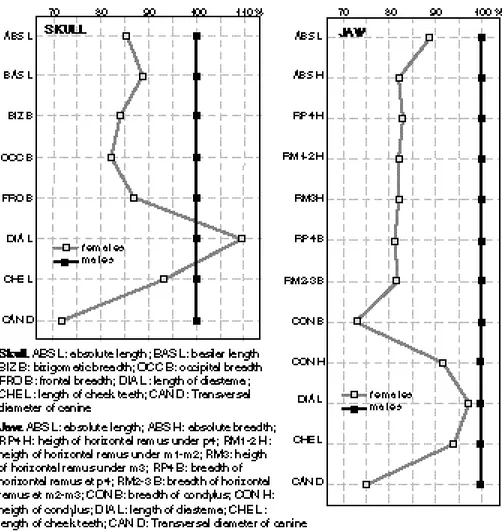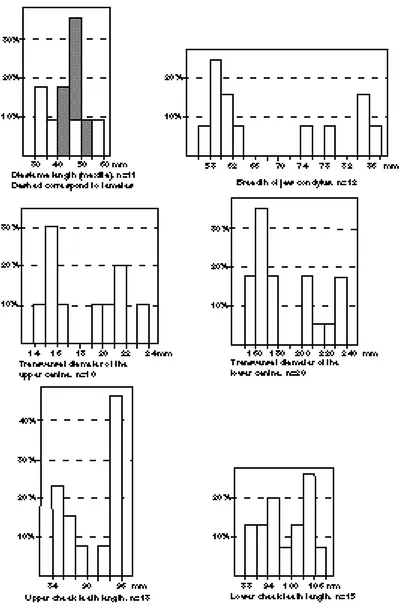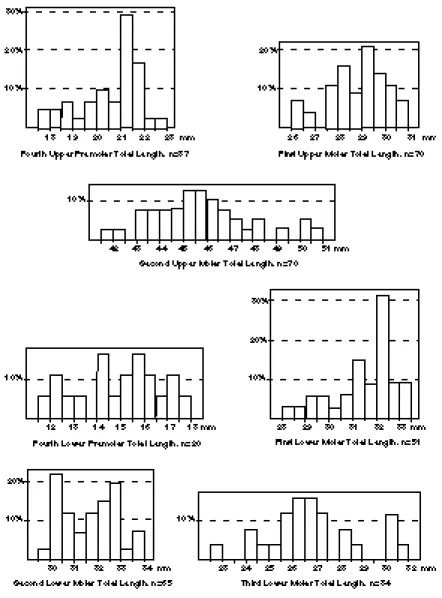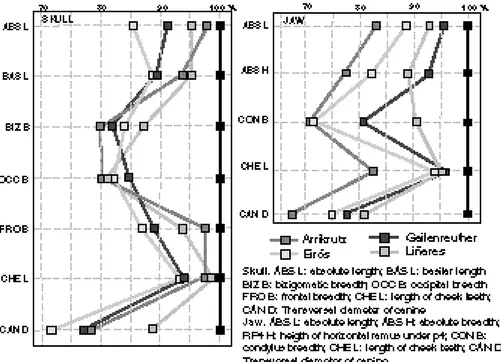A review of the cave bear sex dimorphism
Revisión del dimorfismo sexual del Oso de las
Cavernas
GRANDAL d'ANGLADE, A.
A B S T R A C T
In this paper the influence of sex dimorphism in the population of cave bears from Cova Eirós (Triacastela, Galicia, Spain) is reviewed. The study will be centred in the skull, jaw and teeth, and principally in those parts that are commonly considered as not markedly d i m o r p h i c .
Key words: Ursus spelaeus, sex dimorphism, Eirós cave
INTRODUCTION
The sex dimorphism in the cave bear was studied extensively (KOBY, 1949; K U RT É N 1955, 1976; G R A N D A L, 1993; REISINGER & HOHENEGGER, 1998). Undoubtfully the cave bears, like the extant members of the genus Ursus, presented a well marked sexual dimor-phism. However this dimorphism does not affect all bones of the skeleton with the same intensity.
In bears, the transversal diameter of the canines (upper and lower) presents generally a complete separation of the ran-ges of variation for both sexes. This would be a "complete" sex dimorphism (as defi-ned by KURTÉN, 1955) and it is a very accurate method for sexing skulls and jaws of a cave bear population. When, in a given measurement, the standard ranges of males and females overlap, then the sex dimorphism is "partial", according to KURTÉN (1955) and the sexing of the sample becomes more difficult, and often impossible.
Consequently, in our opinion, metric comparisons between different popula-tions lose all their value, as one cannot dis-tinguish between differences produced by a real eco-geographic variation, and those arising from the existence of a different sex ratio in each deposit. Even in the case of larger sized samples, the sex ratio is not always comparable in each deposit (for a review of differences in sex ratio see WEINSTOCK, 2000).
In this paper we will present first the size differences between sexes studied on the sexable remains for the population of Eirós, and then we will consider the sexual
dimorphism in the cheek teeth. finally we will consider the differences in the sex dimorphism between populations.
The skulls and jaws of the cave bears from Eirós
The main problem when studying cave bear populations in statistical terms, is the often small number of complete bones for an accurate analysis. Even in a site with a good preservation of the remains, such as Eirós, the sample is scarce. Figure 1 shows the ratio diagrams of some measuremets of the skull and jaw of the cave bears from Eirós. The average of female values is expresed as a percent from the averages of males that are the 100%. Number of cases is 8 female skulls, 5 male skulls, 10 fema-le jaws and 5 mafema-le ones.
Ratio diagrams of skull and jaw show the difference between females and males from Eirós. Female skulls and jaws are cle-arly smaller than those from males, but not all measurements reflect the sexual dimorphism in an equal proportion.
Concerning the females, the upper and lower canines show an important degree of sex dimorphism, whilst the cheek teeth length is more close to that of males. The diastema is proportionally longer in fema-les because of the more slender canine and shortened cheek teeth. This feature is more marked in the maxilla.
The female jaws present a narrower condylus than those from males, being the difference of averages even greater than the difference of averages in the lower canine.
The frequency distribution of these commented measurements are presented in figure 2. The distribution of the diaste-ma length shows the striking feature
ady commented. In all other cases, bar diagrams show not normal distribution, but clear bimodality.
The sex dimorphism in the cheek teeth The histograms of the length of the cheek teeth rows in figure 2 show a mar-ked bimodality that allow us to affirm that there is an, at least, partial sex dimor-phism in the size of the cheek teeth.
However, the study of the total length of isolated specimens of cheek teeth
(figu-re 3) shows that the overlapping between the female ranges and the male ones does mask the possible bimodality and only in the cases of the P4, M
1and M2the
distri-bution is clearly not normal.
How does this affect to the study of the population? There are an important point: if the sex distribution is balanced (about 50% males and 50% females) then it should be possible to assume that the dif-ference in the size of the cheek teeth due
to sex dimorphism could be bypassed. But this balanced ratio is not always present in the cave bear populations (K U RT É N, 1955; TORRESet al., 1991; ANDREWS & TURNER, 1992; GRANDAL & VIDAL, 1997; GRANDAL & LÓPEZ,
1998; REISINGER & HOHENEGGER, 1998; W E I N S T O C K, 1999, 2000; GRANDALet al., 2000). Thus, a predo-minance of males in the population would lead to a increment in the average values,
402 GRANDAL d’ANGLADE, A. CAD. LAB. XEOL. LAXE 26 (2001)
whilst a predominance in females would decrease the average.
The influence of sex dimorphism in different populations
Another important question that should be examined is the possibility of
the existence of a different degree of sex dimorphism in different populations. Figure 4 shows the ratio diagrams for some of the measurements of skulls and jaws from four different sites. Specially in the jaw, the different incidence of sex
dimorphism in each population is well marked. This is an interesting matter that should be studied with more detail. One of the possible explanations could be the effect of sexual selection, more marked in those sites corresponding to a non favoura-ble environment, although this hypothesis must be tested further on.
ACKNOWLEDGEMENTS
This paper is a contribution to the Research Project XUGA PGIDT 00 PXI16201PR.
404 GRANDAL d’ANGLADE, A. CAD. LAB. XEOL. LAXE 26 (2001)
REFERENCES
ANDREWS, P. & TURNER, A. (1992). Life and death of the Westbury bears. Annales Zoologici Fennici,28(3-4): 139-149
GRANDAL d'ANGLADE, A. (1993). El Oso de las Cavernas en Galicia: el yacimiento de Cova Eirós. Serie Nova Terra, 8. O Castro, A Coruña. 246 pp.
GRANDAL d'ANGLADE, A. & VIDAL ROMANÍ, J. R. (1997). A population study on the Cave Bear (Ursus spelaeus Ros.-Hein.) from Cova Eirós (Triacastela, Galicia, Spain). Geobios, 30(5): 723-731.
GRANDAL d'ANGLADE, A. & LÓPEZ GONZÁLEZ, F. (1998). A population study on the Cave Bears (Ursus spelaeus Rosenmüller-Heinroth) from Galician caves, NW of Iberian Peninsula. Cadernos do Laboratorio Xeolóxico de Laxe,23: 215-224
GRANDAL d’ANGLADE, A., LÓPEZ GONZÁLEZ, F & VILA TA B O A D A, M. (2000). The cave bears from Galicia (Spain). Geoloski zbornik,15: 20-24
KOBY, F. (1949). Le dimorphisme sexuel des cani-nes d’Ursus arctoset d’Ursus spelaeus.Revue Suisse de Zoologie,56: 675-687
KURTÉN, B. (1955). Sex dimorphism and size trends in the cave bear.Acta Zoologica Fennica, 90: 1-47
KURTÉN, B. (1976). The cave bear story. New York: Columbia University Press.
REISINGER, C. & HOHENEGGER, J. (1998). Sexual dimorphism in limb bones of Late Pleistocene cave bear (Ursus spelaeus, Carnivora, Mammalia) from three caves in Eastern Alps (Austria and Italy). Bolletino della Società Paleontologica Italiana,37(1): 99-116
TORRES PÉREZ-HIDALGO, T., COBO R AYÁN, R. & SALAZAR RINCÓN, A. (1991). La población de oso de las cavernas (Ursus spelaeus p a r v i l a t i p e d i s n. ssp.) de Troskaeta’ko kobea (Ataún, Guipúzcoa). Munibe,43: 3-85
WEINSTOCK, J. (1999). The Upper Pleistocene mammalian fauna from the Große Grotte near Blaubeuren (southwestern Germany). Stuttgarter Beiträge zur Naturkunde, Ser. B,277: 1-49



